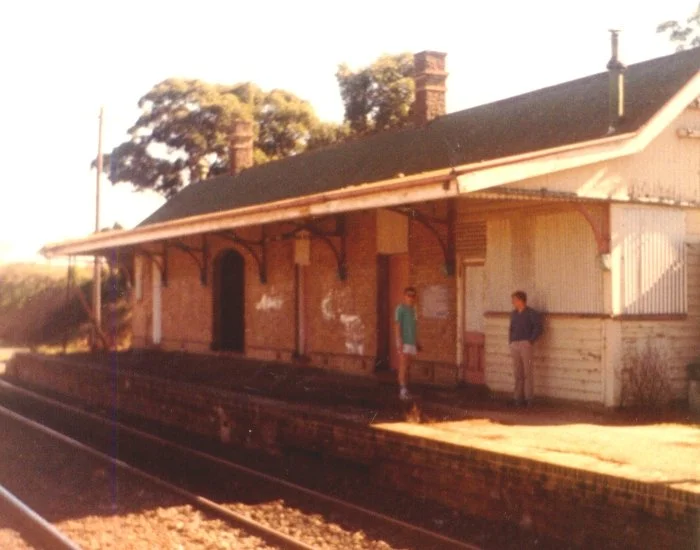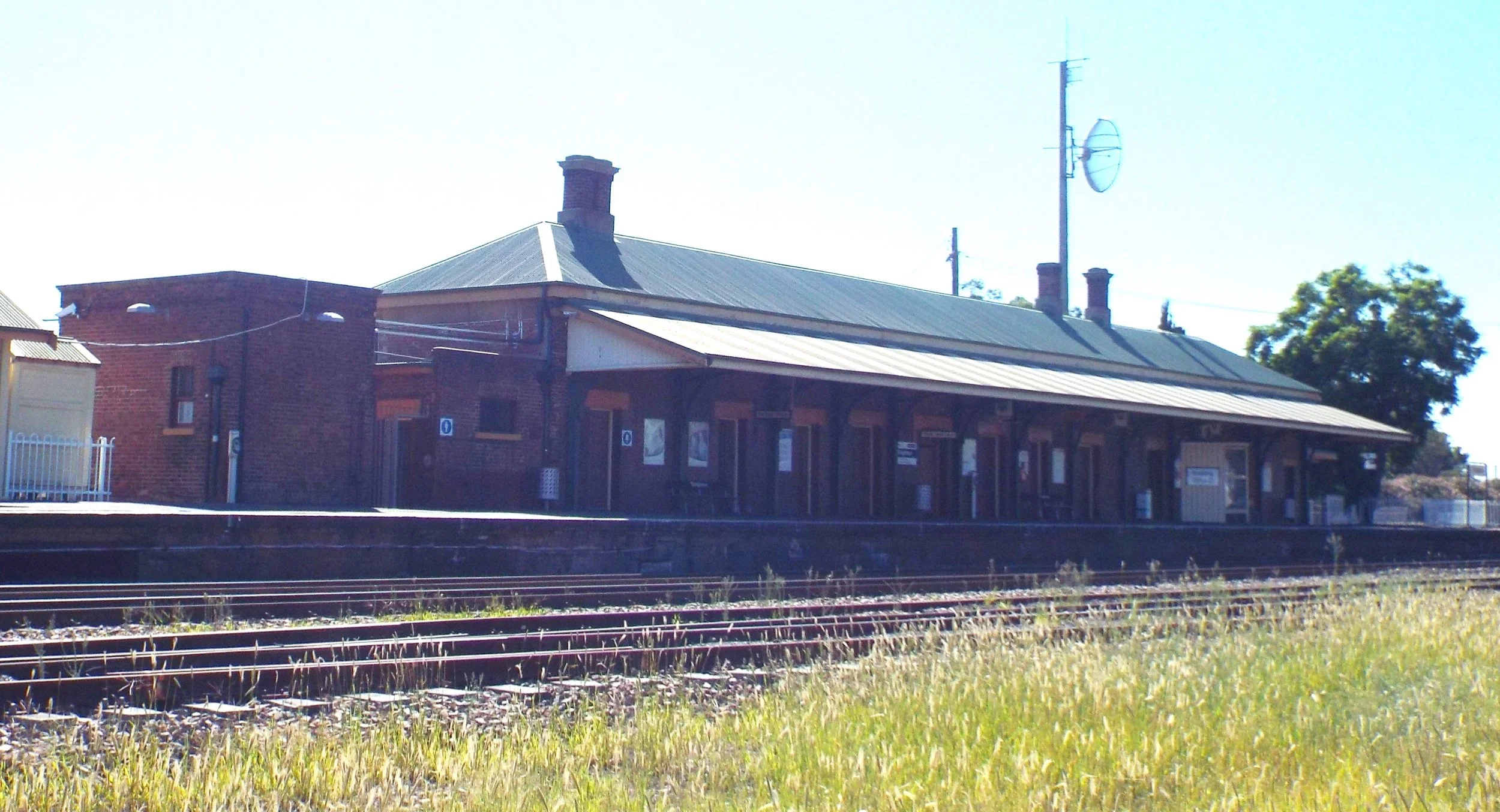Onward to Singleton 1858-1863
Following the opening of the railway to West Maitland in July-August 1858, questions were asked about when the extension of the line toward Singleton would begin. John Robertson, Secretary for Lands and Works, replied that 27½ miles (44.3 km) was to be constructed but that there was a requirement for a pause of 40 days for notice of objections by proprietors of land through which the line would pass.
Progress
On 6 November 1858, plans for the extension were exhibited for inspection at West Maitland Court House. The line of railway was to go through the lands of the following proprietors: Messrs Otto Baldwin, Joseph Ede Pearce, James Gould, Owen and Beckett; James Weston; Rev Dean Lynch; Mrs E. Pilcher and Mrs Jane Foss; and Messrs Bourn Russell, Rutherford, Dowers and Winder.
William Wright, who had built the East Maitland to West Maitland section of the railway line, did not have his contract extended. Instead, a series of small contracts were let.
By 21 April 1859, the line workings had advanced as far as the Stony Creek bridge (Farley), and the fencing for the railway had reached Lochinvar. A number of obstacles had been overcome including making a cutting through sandstone, building bridges over low swampy ground and blasting a bed of whinstone at Welshmans Hill, Stony Creek. Whinstone was a term used to describe any hard, dark coloured rock, usually basalt or dolerite. Blasting powder was used to break it up. It was recorded that up to a quarter ton of blasting powder was used per week.
By 21 May 1859, the line was complete beyond Dagworth Road. This road was the extension of Regent Street and is now Mount Dee Road and Cessnock Road.
By 5 July 1859, work had begun at the Lochinvar end of the line. Mr Willcox, agent for English railway builder Sir Morton Peto, had commenced operations near Lochinvar, and the railway to Singleton was to be completed by contract on 31 December 1860.
In mid-August 1859 the NSW Railway Branch announced that the extension from Lochinvar to Black Creek, a distance of 9 miles and 10 chains (14.7 km), would commence shortly. The following month notice was given that the section from Black Creek to Singleton, a distance of 14 miles and 10 chains (22.7 km), would also commence shortly.
On 19 November 1859, tenders were called in the Government Gazette for a contract to supply 41,000 ironbark or pure box sleepers, or for any portion of the same, not being less than 4000 for the railway. By 29 November 1859, the whole of the line had been cleared as far as New Frengh, a distance of about 6 miles from the terminus in Singleton. Large workshops for the railway and an office for Mr. Ballard, Superintendent of the Works, had been erected at Belford.
January 1860 witnessed a slowing down of work on the railway extension attributed, as the Mercury (10 Jan 1860) reported, to a number of the railway workers, who were also local farmers, taking time off to go reaping.
In January 1860, Joseph Martindale from Melbourne, won the contract to build the next section of the railway. He introduced Chinese labourers to the construction.
At Stoney Creek (Farley), a timber station building had been erected and a station master’s residence planned. A siding had been constructed to receive produce from the farms along Wollombi Road. A more substantial brick station was under construction at Lochinvar.
Farley Railway Station, 1987.
The station building is on the up platform, looking in the direction of Singleton.
The line to Lochinvar was opened by the Chief Commissioner of Railways on Wednesday, 27 June and was opened for public traffic on Monday 2, July, 1860.
Lochinvar Railway Station looking in the direction of Singleton, 1987
Construction continued. Cuttings at Harpers Hill, through rock, were formidable. In addition, a viaduct was constructed across the Black Creek floodplain, and a station building at Black Creek commenced. The Mercury reported that there were 100 men working on the line between Maitland and Singleton at that time.
The line from Singleton towards Maitland commenced and, by 10 April 1861, ballasting had begun. By 22 April, trains were running as far as Branxton and on 13 May, tenders were called for the construction of a goods shed at Branxton station. By 24 May, 350 men were employed on building the railway.
Singleton station was to be opened on St Patricks Day, 17 April 1863 but heavy rains and flooding in February affected the line and repairs delayed the occasion. By 5 March 1863, considerable progress had been made on the building of Singleton Railway Station, and the goods shed was expected to be completed in three months.
The opening date was settled for Thursday, 7 May 1863.
Singleton Railway Station platform, 2016.
(Photograph: Lawrence Henderson)
Accidents
The building of the Maitland to Singleton section of the railway, as with the earlier sections, had accidents that highlighted the dangers of the work, the rudimentary if non-existent safety precautions, and the nature and composition of the workforce. Accidents were regularly reported in the Maitland Mercury. The following provide a sample.
During July 1859, a man named Evans was lighting a blast at Stony Creek when it exploded prematurely, lifting him 8 feet in the air. He was rushed to hospital and, although disfigured, survived the explosion. Another, unnamed, man broke a leg and collarbone when a sling rope slipped and the load fell on him. He was conveyed to hospital and made a favourable recovery. Patrick Carroll, a workman on the railway, leaped from the train while it was in motion and broke a leg which was amputated at the Maitland Hospital, thereby depriving him of a paying job. The Committee of the Hospital obtained for him a position as gate-keeper on the Wallsend line.
In October 1859 William Hoskins was working on a cutting near Anvil Creek when a bank collapsed and struck him. He was immediately released by his colleagues but died soon after.
In December 1859 a carpenter named Savill was working on the Stoney Creek bridge when he fell 20 feet and received severe head injuries. At the time the accident was reported, it was thought the injuries would prove fatal.
In November 1861, workers were loosening out a stone of about a hundredweight in a cutting near Black Creek, when the stone tumbled to the bottom of the cutting where it struck 29 year-old James England Cable. He was killed instantly.
Opening 7 May 1863
The Maitland to Singleton section of the Great Northern Railway was finally opened on 7 May 1863. The new Governor-General, Sir John Young, was invited to take part in the ceremonies.
The Governor and his party arrived in Newcastle on the steamer Coonanbara early in the morning and then, after a brief reception, travelled by train to Singleton with stops at East and West Maitland where he was greeted with complimentary addresses. At West Maitland, Bourn Russell MLC, included in his welcome speech the following glowing account of Maitland:
As a key to the vast interior, and the importance of your Excellency's visit, we desire to bring under your Excellency's notice a few brief statistics of this district which forms a radius of about thirty miles, of which this town is the natural and commercial centre.
It is the seat of a Bishop, has twenty-nine churches and chapels, two superior schools, forty ordinary schools, besides many infant and Sunday schools; three schools of arts, with young men's debating societies and lectures; one theatre; has an agricultural and horticultural society combined, a vineyard association and cotton growing society, and several minor societies; has six savings banks, one penny bank, three steam saw mills, nine steam flour mills, four steam engines for other purposes, two foundries, three tanneries, three fellmongery establishments, four tobacco manufactories, and many other works of art and industry; seventy-seven public hotels and inns, an hospital, ?? employs six steamers with its exports. The sales of cattle within the last month have been of horned cattle, four thousand five hundred; horses, five hundred and sixty; sheep, four thousand seven hundred and fifty.
The train arrived in Singleton at about 11 o’clock, and was greeted by a dense crowd of people assembled on the platform. It was estimated that three thousand people from Newcastle and East and West Maitland had travelled by train to Singleton for the celebrations. Many houses displayed flags and an elegant triple arch formed of foliage displayed the word Welcome in alternate blue and pink letters. The Newcastle Volunteer Artillery had taken one of their field pieces on an earlier train, to fire a salute on the arrival of the Governor.
The vice-regal party then travelled by carriage to the Royal Hotel escorted by by the West Maitland, Morpeth, East Maitland and Newcastle Volunteer Rifle Companies. At the hotel there were welcome speeches and addresses on behalf of a variety of local organisations, and the visitors along with town dignitaries sat down to a celebratory dinner.
In the evening, entertainment for the crowd was provided by the Rifle Company’s bands and the festivities ended with a fireworks display.
Celebrations continued into the night with the Railway Ball held in ‘the spacious pavilion at the rear of the Royal Hotel’. Nearly 100 people attended with the Governor present during the early part of the evening. The East Maitland German band provided the music. One feature of the evening's entertainment was the performance, for the first time, of The Singleton Railway Galop, described as ‘a very beautiful piece of music and much admired’. It was composed expressly for the occasion by Marmaduke Wilson and published by J.W. Hillcoat of High Street, West Maitland. A copy of the Galop, with a satin wrapper printed in gold, was presented to the Governor during the ball.
Advertisment for the Singleton Railway Galop, Maitland Mercury, 2 May 1863.
Following the completion of the Maitland to Singleton section of the railway, the next decades saw then network extend in different directions. These extensions are the focus of Part 8, the final part, of my account of the building of the Great Northern Railway.




